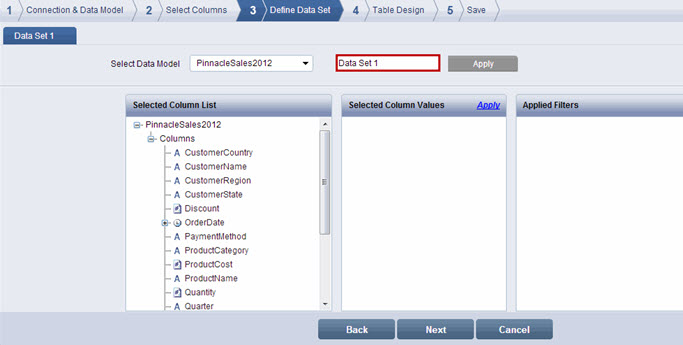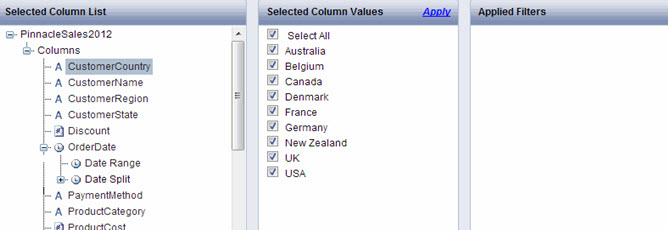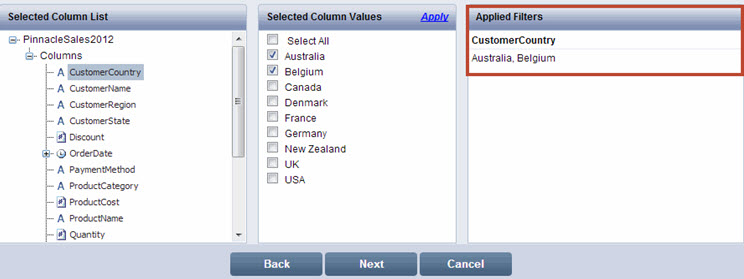
The Define Data Set feature allows setting up and defining the data set to reflect how you need the data set represented in the widget.
To define a data set:
If needed, modify the data set name in the corresponding text box.

Click Apply to save the change.
In the Selected Column List section, select the column name for which you want to view the column values. The column values are displayed in the Selected Column Values section. By default, the Select All check box is selected in the Selected Column Values section.

![]() Note:
Note:
Date columns denoted by the ![]() sign are categorized into the following sub columns:
sign are categorized into the following sub columns:
Date Range – Select a date range option if you want the data in the widget automatically updated for the selected date range on an ongoing basis. The date range options are Week to Date, Month to Date, Quarter to Date, Year to Date, Last Week, Last Month, Last Quarter, Last Year, and Custom Date.
For example, if you select the Last Month date range option, and view the widget in the month of April, the metrics for the month of March are automatically displayed. If you view the same widget in June, the metrics for the previous month, May are automatically displayed.
The only exception to the automatic update is that if you select Custom Date range, the specific Start Date and End Date you select are used on an ongoing basis and are not automatically updated.
Date Split – selecting a date split sub column presents the metrics only for the specified date. The date split options are Year_Of_Date, MonthYear_Of_Date, Quarter_Of_Date, Month_Of_Date, Week_Of_Date, Day_Of_Date, and WeekDay_Of_Date.
For example, if you select the Year_Of_Date option, a list of all unique year values available for that date column is displayed. If you select 2012 as the value and apply the filter, the widget will continue to present the metrics of 2012 irrespective of when you view the report.
You can select either the Date Range sub column or the Date Split sub column
If needed, either clear the Select All check box and then select values or clear the check boxes corresponding to the values that you do not want to include.
Click Apply. The selected values are displayed in the Applied Filters section. For example, if you want to design a widget to present Unit Shipments only for two Countries – Australia and Belgium, you can select the Country column and only select Australia and Belgium. In this case, you have defined the data set for the widget to reflect data only for these two countries. The data set you define can be changed by modifying the widget while viewing the dashboard.

![]() Note:
Note:
You can either remove or modify the applied filters
To remove the applied filters:
Select the column name in the Selected Column List section.
In the Selected Column Values section,select the Select All check box and click Apply. The existing values in the Applied Filters section for the selected column are removed
To modify the applied filters:
Select the column name in the Selected Column List section.
In the Selected Column Values section, clear the check box for the filter value you want to remove.
Select the check box for the filter values you want to add and click Apply. The existing values in the Applied Filters section are modified based on your selection
For detailed information on the various types of filters, see Working with Filters
Click Next. The Table Design page is displayed.
![]() Note:
Note:
Click Back to go to the Select Columns page. Click Cancel to exit creation of widget.
<<Select Columns | Design>>